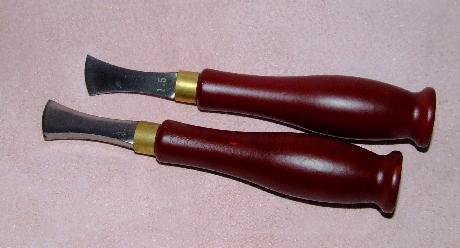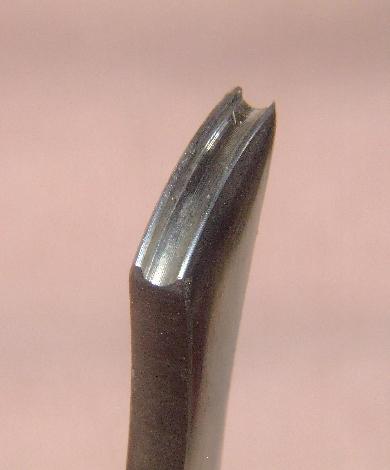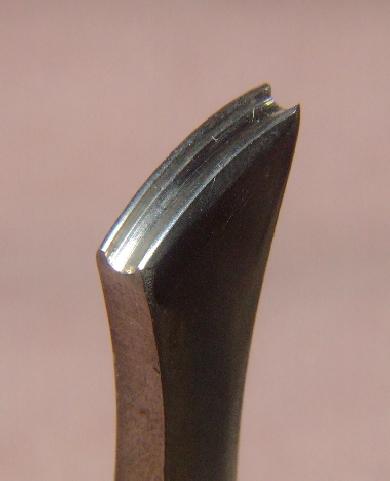-
Posts
5,928 -
Joined
Content Type
Profiles
Forums
Events
Blogs
Gallery
Everything posted by fredk
-
I got a 1.5mm and a 2.5mm I don't use creasers and I didn't need them but I thought I'd get a couple of fixed distance ones just in case, to have available These actually worked out at about £4.45 each! Checking my notes; these were to be delivered in 14 to 21 days. After the 21 says I enquired to where they were and the seller gave me a big refund of part of the price and an apology for the delay. These arrived about 10 days later, thus total delivery time was about 31 days. Not that that has any bearing on how long something would take to get you
-
Last month I bought two cheap creasers out of China. They cost me about £7.60 each. Even their creasing part is superior. Two views of the 2.5mm one
-
All the other options you lot have mentioned are good for certain purposes, but not very good for spreading thin liquid glue, especially over a large surface and especially doing it quickly
-
Without something to support the magnet it wont stay in place for long You can get magnet closures which have a metal surround which has two or more prongs on it which pierce the leather and are folded over. You can also get magnets encased in a thin plastic pouch which can be glued to the leather. For the occasional time I've used a magnet I've glued it in place, just to hold it whilst working, then glued a very thin piece of material or leather over the backside of the item to hold the magnet in place
-
In the UK we have a latex based glue called Copydex. It was famous for it smelling of fish, but sadly no longer Its a very liquid glue. Not as runny as woodworkers PVA but almost. Each bottle of Copydex comes with a brush built into the inside of the screw off lid. But those brushes get bunged up and useless after a time. I started looking for glue brushes in my local hardware and decorating stores. All searching was fruitless, the shop staff didn't even know what I was looking for. An on-line search found me glue brushes, but also this; A silicone glue brush. It costs about £10 It reminded of something else; a pastry brush. I bought one in a supermarket called ASDA for only £1.50 I tried it last night and it worked very well, but I think I'll trim the brush a bit shorter so they are a little stiffer. Only real down side is this is too wide to fit into the Copydex bottle
-
I used to use an old metal biscuit box for my oven when I cooked fish at the beach after catching them Dig hole, light fire in hole, scape out some of the fire, put biscuit tin into hole on top of fire, put rest of fire on top of box lid, then cover with sand. Hopefully, having remembered to put cleaned and gutted fish wrapped in aluminium foil inside of box, along with a few small taties and onions Continue fishing, then remember dinner should be cooked then spend ages trying to remember just where you buried the tin oven, searching with a small battery flashlight which is about to go out - here sea fishing is done in darkness of twilight to dawn
-
Thanks for the explanation on how you make the stamp(s) Do you use a release agent, such as talc, between the polymer clay and the leather?
-
Sharp = a sharp needle, like a glovers needle
-
My #1 son still has an 8-track. In his 1978-year Cadillac Coup DeVille. I think he pinched all the tapes from my '78 Caddy for his un
-
A slight deviation; I want to buy some EVA foam, to put into boxes, with cut outs for holding game pieces. The cheapest I can get is a piece 50 cm x 50 cm for £15 delivered. Or, from the same supplier, a piece 1m x 1m for £18 delivered. At the moment I want only a small [about 25 cm x 20cm] piece to check if my idea will work out, but if it does I'll use the rest of the EVA, but if it doesn't I'll have to find a use for it all!
-

Dog collar bling: spots or rivets?
fredk replied to ButtonLady's topic in Collars, Cuffs, Leashes and Leads
No problems. One uses a rod/bar setter with a dome shape in the end. I use a bar one size larger than the rivet, eg for a 6mm rivet head I use a 7mm setter -

Dog collar bling: spots or rivets?
fredk replied to ButtonLady's topic in Collars, Cuffs, Leashes and Leads
You can get domed head ready-rivets. I use them when I want the rivet to be more decorative https://www.ebay.co.uk/itm/181337022618?_trkparms=amclksrc%3DITM%26aid%3D1110006%26algo%3DHOMESPLICE.SIM%26ao%3D1%26asc%3D237808%26meid%3D25be4fdc25b342a9a51054d8f8cc16d9%26pid%3D101195%26rk%3D12%26rkt%3D12%26sd%3D173950563887%26itm%3D181337022618%26pmt%3D1%26noa%3D0%26pg%3D2047675%26algv%3DSimplAMLv9PairwiseWebMskuAspectsV202110NoVariantSeed&_trksid=p2047675.c101195.m1851&amdata=cksum%3A18133702261825be4fdc25b342a9a51054d8f8cc16d9|enc%3AAQAGAAACEKyApwK%2FefsMJoQXTtwyzIPiLlyq8g8hwMr2qnuOcpGnokIWj1HbCI2Idd68n9p22JtdKPWIQg79oDp6mEui0M0pp3IFv3o8kp5RfVxnsUfyjOcu7IGfaqx5rZn7GpVXFWsLl8BMoTXYS8najzmMyazeMZTSCxqr9r6wfyRFHNhtjeEG5Jgc%2Bi2Yrc24kos5DdCWeybheiJDTwwmz0gfF9nqkv%2FY%2FF4mketFVw1yNPskQ7DMTFyBatbZnLNYF80NN7LOVrYQ4yZfMVO7mJ3c79P7hsEmw8iEuQ51DjDzpnmwRrvN7m7v6Wp3%2FU8StECi%2BgkWkvrPiyx%2BX4LVvm4pAngsFDuYgmiDFZBu7oGjau3H0ZvUS517Gs0%2FdBfBRG%2FizRu%2FVhf2HU2fp9Bc0VDUUR81wVrm6uJoJdTUpvLcn46D08BHg70Ezbdtjzrx%2F5CahOjfx2t9%2F7S3faSrkmQcwGfK9IwVwG6NSXMSlzY3JJ7hDduA6ZXtLxIOHRl%2BgnK0636QMylEeiml9Nic5hKsGrFlK0cX5TlUYMiIyNy%2BNON0lSy%2F0rR0cMlLm58hi5S0HsSSTHBtdxSkzxzH947VmX%2BAj3ErPEvJxgyvryjNYw%2B7yc4d0Uq1oDRScs4nHeb874I%2FtdPZMgVjOY8CMj%2Bj41j6iaS6Wpb%2BPMMrPMthE1QhxYf8WVl1rHOLopUWn68lsA%3D%3D|ampid%3APL_CLK|clp%3A2047675 -
Top right of screen - your name Click on that, drop down menu appears, top option = 'profile' Click on that which gives you a new page Way over on the left is your avatar. In the lower left corner is a little landscape picture, click on that and you get a sub-page with options on how to upload a picture for your profile
-
Le Prevo have been cutting back on their buckles, loops and dees type hardware. Its not a 1/10 of what it used to be Another reason why I have bought in bulk - whilst its available
-
Ouch! that hurts 32oz bottle of dye, 20 x 20mm brass loop & 20 x 30mm brass loops. Weight, approx 1.5kg, £18.50 from Le Prevo to me. [not Le Prevo's fault] It was the same price for just the dye, or just one set of brass loops
-
Having learnt a bad lesson about having not enough hardware on hand years ago I now buy in bulk. If I'm going to make just a few of something I buy in enough hardware for 10, 20 or even up to 50 of that item or similar. I buy bargains / discounted hardware whenever I spot it even if I have no immediate need for it. As I see it, the hardware doesn't have a 'use by' or 'best before' date on it like bread or meat, so it'll stay fresh until I need it. In the past, I too went to Charity shops [aka thrift stores to you heathens!] and bought cheap belts or handbags et cetera. Good for one-off hardware but occasionally I hit good where a major store had off loaded quantities of certain fashion belts. All made in that cheap pretend leather/PVC, but with quality buckles. I have no leather supply place near me and getting anything posted to me costs a fortune. It costs as much to post 50 SB buttons as it does 500. Thus, by pro-rata the hardware item works out cheaper in quantity
-
Almost, but we both spoke the same language. A fast exchange, took about 5 seconds, a spit on the hand and a slap of hands, deal done and binding
-
I think a loop stitch with different coloured threads could be hand sewn with one of these; An Auto Awl Use coloured thread A to run through the loops of coloured thread B which is on the bobbin edit; ah, Dwight got posting whilst I was still writing
-
If you want this to look good, take out those rusty rivets and replace with brass double-headed ready-rivets Take out the rivets, sew up then replace the rivets omo
-
I build in any 'discount' that might be expected years ago when I had a photo business I was the only photographer willing to do weddings and 1st communion photos for the local gypsies. The other snappers refused to do for them as the gypsies always wanted discounts. I simply added a bit on to the price for taking off for the discount. eg a wedding portfolio would be £150, I made it up to £180. Still cheaper than the other snappers. Then when the gypsy man was paying, in advance, we negotiated, step-by-step till he got about £20 or £25 off the £180. He went away happy cos he wrangled a big 'discount' out of me and I was happy cos I got my actual price out of him! I tried to tell the other snappers about this but they were too thick to understand. I got a good reputation amongst the gypsies that I could be bargained with and I got a lot of business out of them This translates to my leather goods. Depending on what it is and where I was selling it, I added on a few extra £££, and 'discounted' that price by ££ if asked, only if asked though At artisan fairs, open table markets, car-boot sales, et cetera, buyers like to think they've got a 'bargain' even if its only £1 off the price Another thing I have and do is, I have a small basket of odd shaped and sizes of small leather bags or pouches made from scrap leather. They are decent looking. I price them at £3 each. I'll give one of these to the customer as their extra. In N.I. / Ireland when you buy something in a private deal its traditional to give the seller some money back as their 'lucky penny', This could be anything from £1 to £20 depending on the amount involved in the deal. So even if you/I haven't given 'discount' some people expect their 'lucky penny' Its all very confusing
-
Your leather case set looks useful In the RAF [and USAF] we used to get regularly issued with a card-board cased set like that. It was called a 'house wife'. No scissors but often a small razor bladed knife, buttons to suit our uniform, lots of thread, sewing needles, straight pins, safety pins, needle threader and a collar stud. I still have one of my USAF issue kits somewhere
-
Some years ago Donaghadee hosted an 'artisan' market. There was one chap who did wood carvings out of sea drift-wood. He had a fairly large sign, about an A4 size, which he placed on one of his pieces. On this card was written £50,000. People stopped, and asked him was that really the price? His reply was 'oops, that sign has fallen on to there, that item is only £25' As I watched he got about 75 - 80% of sales. That £50,000 card was moved about regularly during the event
-
I like and enjoy almost all types of music so 99% of the time - 24/7, my radios are on the UK's BBC Radio 2. There is a decent selection of both old and new music through the day and the station is free of commercial adverts. The few times that there is a radio programme with music I don't want to listen to I'll put on a CD of Classical, Traditional, Light Comic Opera, 60s, 70s or 80s music, or just about anything which takes my fancy or suits my mood
-
True story; a certain road junction in Belfast was designed by a bicycle riding development designer. A couple of years ago some EU inspectors declared that road junction as the most confusing and most dangerous junction in Europe and possibly in the World!





